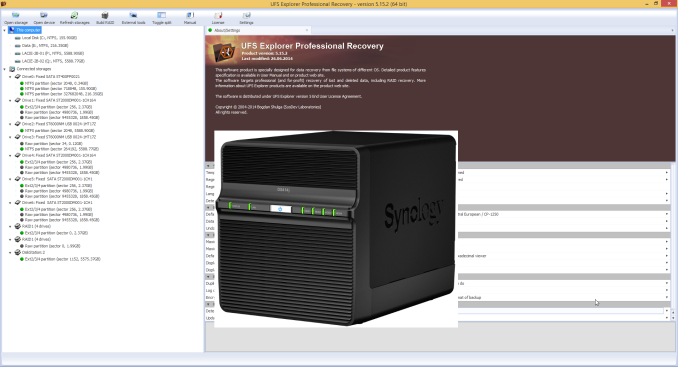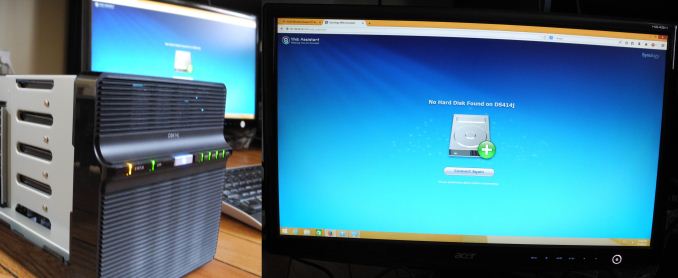Recovering Data from a Failed Synology NAS
by Ganesh T S on August 22, 2014 6:00 AM EST
It was bound to happen. After 4+ years of running multiple NAS units 24x7, I finally ended up in a situation that brought my data availability to a complete halt. Even though I perform RAID rebuild as part of every NAS evaluation, I have never had the necessity to do one in the course of regular usage. On two occasions (once with a Seagate Barracuda 1 TB drive in a Netgear NV+ v2 and another time with a Samsung Spinpoint 1 TB drive in a QNAP TS-659 Pro II), the NAS UI complained about increasing reallocated sector counts on the drive and I promptly backed up the data and reinitialized the units with new drives.
Failure Symptoms
I woke up last Saturday morning to incessant beeping from the recently commissioned Synology DS414j. All four HDD lights were blinking furiously and the status light was glowing orange. The unit's web UI was inaccessible. Left with no other option, I powered down the unit with a long press of the front panel power button and restarted it. This time around, the web UI was accessible, but I was presented with the dreaded message that there were no hard drives in the unit.
The NAS, as per its intended usage scenario, had been only very lightly loaded in terms of network and disk traffic. However, in the interest of full disclosure, I have to note that the unit had been used againt Synology's directions with reference to hot-swapping during the review process. The unit doesn't support hot-swap, but we tested it out and found that it worked. However, the drives that were used for long term testing were never hot-swapped.
Data Availability at Stake
In my original DS414j review, I had indicated its suitability as a backup NAS. After prolonged usage, it was re-purposed slightly. The Cloud Station and related packages were uninstalled as they simply refused to let the disks go to sleep. However, I created a shared folder for storing data and mapped it on a Windows 8.1 VM in the QNAP TS-451 NAS (that is currently under evaluation). By configuring that shared folder as the local path for QSync (QNAP's Dropbox-like package), I intended to get any data uploaded to the DS414j's shared folder backed up in real time to the QNAP AT-TS-451's QSync folder (and vice-versa). The net result was that I was expecting data to be backed up irrespective of whether I uploaded it to the TS-451 or the DS414j. Almost all the data I was storing on the NAS units at that time was being generated by benchmark runs for various reviews in progress.
My first task after seeing the 'hard disk not present' message on the DS414j web page was to ensure that my data backup was up to date on the QNAP TS-451. I had copied over some results to the DS414j on Friday afternoon, but, to my consternation, I found that QSync had failed me. The updates that had occurred in the mapped Samba share hadn't reflected properly on to the QSync folder in the TS-451 (the last version seemed to be from Thursday night, which leads me to suspect that QSync wasn't doing real-time monitoring / updates, or, it was not recognizing updates made to a monitored folder from another machine). In any case, I had apparently lost a day's work (machine time, mainly) worth of data.











55 Comments
View All Comments
Filiprino - Monday, August 25, 2014 - link
Well, if you have a service managing a RAID volume, that is, you have the raid volume mounted, obviously you have to first unmount it, so you have to stop the daemon...Synology's FAQ assumes that the RAID volume is not mounted and that no daemon has interacted with the RAID device first.
So I would not recommend Windows either. And probably you can get by with more complicated cases with Ubuntu than with Windows and UFS explorer.
Anyways, I'd use a GNU/Linux box with ZFS which as no write holes.
cyberguyz - Tuesday, August 26, 2014 - link
The best disaster recovery plan is backup, backup, backup. I've lost hundreds of gigabytes of data before so I know how valuable having a solid backup process is.My DS 412+ runs automated backups done to external drives twice a week (rotated on a monthly basis).
batatudo - Tuesday, September 16, 2014 - link
I have the Synology DS211j and last year I have some problem with one of the disk, at that moment I didn't have another disk to replace the failed one, so my priority was to backup the data from the good drive first. so I searched the internet and found a program called "File Scavenger 4.2" for windows, I was able to recover the data using that program, everything was very easy, I think that program is very similar to USB Explorer, is good to know we have several options to restore the data. After that event I also attached two external USB drive to my NAS and started making backups daily and weekly. Also I'm backing up the most important forlders to Amazon S3, is very cheap and best of all, you can access your data even through Internet Explorer or any other Amazon S3 client. Remember to make at least 3 backups, and one of them must be online or in another physical location.Midav - Thursday, June 16, 2016 - link
Only one month ago i had said just the same: I Have A RAID So My Data Is Backed Up. So i'm knowing about this topic almost evething now. This text is good, there are the most common RAID in it, but i can to advise the blog hetmanrecovery (com). Hetman Software real helped me with Data Recovery, and if you beginner in these questions, it'll help you too.mmuu296 - Sunday, January 21, 2018 - link
it is so interesting!!!!